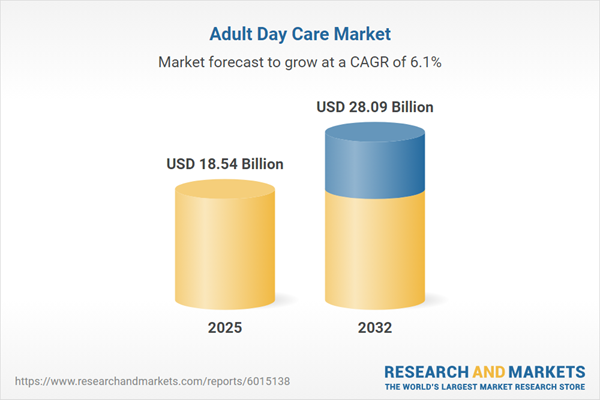Speak directly to the analyst to clarify any post sales queries you may have.
The adult day care market is at a pivotal point, driven by increased demand for comprehensive, community-centered care solutions for aging adults and those with diverse healthcare needs. Providers are rapidly evolving their service models, digital integration, and operational strategies to meet both regulatory requirements and rising client expectations.
Market Snapshot: Adult Day Care Market Size & Growth
The adult day care market grew from USD 17.48 billion in 2024 to USD 18.54 billion in 2025. With a projected compound annual growth rate of 6.10%, the market is anticipated to reach USD 28.09 billion by 2032. This robust growth aligns with increased prevalence of chronic conditions, greater emphasis on community-based care, and evolving funding structures.
Scope & Segmentation of the Adult Day Care Market
- Service Types: Health and social activities, meals and nutritional support, personal care, recreational activities, transportation
- Funding Sources: Medicaid, Medicare, Veterans Affairs, private pay
- Ownership Types: For-profit, government owned, nonprofit
- Service Settings: Center-based day care, home-based day care
- End Users: Adults with disabilities, seniors, dementia and Alzheimer’s patients
- Age Groups: 18 to 64, 65 and above
- Regions: Americas (including North America and Latin America), Europe, Middle East and Africa, Asia-Pacific
- Key Companies: Addus HomeCare Corporation, Brookdale Senior Living, Sunrise Senior Living, Maxim Healthcare Services, BrightStar Care Franchise, Home Instead, Comfort Keepers International, Right at Home, Visiting Angels, Senior Care Centers
- Technologies and Innovations: Telehealth platforms, remote monitoring, digital intake systems, cognitive stimulation therapies, outcome tracking dashboards
Key Takeaways for Senior Decision-Makers
- Integrated care models now blend clinical oversight with social engagement, transforming day care centers into holistic community resources.
- Personalized care plans and technology adoption, such as telehealth and real-time data, enhance participant monitoring and optimize daily activities.
- Collaborations across healthcare systems, nonprofits, and technology providers are streamlining care delivery and enabling scalability through public-private partnerships.
- Providers are diversifying funding approaches, from compliant government billing to value-added private pay packages, to attract multiple client segments.
- Emerging regional differences highlight the importance of adjusting care models to local regulatory and cultural contexts, especially as urbanization and aging accelerate demand in Asia-Pacific and the Americas.
- Lean management strategies and data analytics initiatives are becoming central tools for optimizing cost structures and enhancing resource allocation.
Tariff Impact: Navigating Cost Pressures
Recent tariff adjustments have increased operational costs for key supplies, including medical devices and transportation equipment. Providers have responded by forging partnerships with domestic manufacturers, utilizing cooperative purchasing, and implementing lean cost management. These adaptations help mitigate risks and maintain service quality amid changing trade dynamics. Advocacy for tariff exemptions and local production continues to be a strategic focus to ensure long-term sustainability.
Methodology & Data Sources
This research integrates in-depth executive interviews, detailed reviews of regulatory and industry documents, and multi-stage validation with subject matter experts. Combining qualitative findings with secondary data ensures reliable, actionable insights. The methodology employs segmentation analysis, operational benchmarking, and risk assessment, creating a robust foundation for evaluating market trends and best practices.
Why This Report Matters for Senior Executives
- Access a comprehensive view of adult day care market dynamics, segmentation, and growth drivers tailored for strategic planning.
- Develop informed decisions on technology investments, regional expansion, and tailored funding strategies to meet evolving demands.
- Benchmark your organization’s initiatives against leading providers and innovative operational models across diverse markets.
Conclusion
The adult day care market is advancing rapidly, shaped by demographic change, regulatory reforms, and digital innovation. Leaders who embrace integrated care, technology adoption, and collaborative models will be well positioned for long-term value creation in this essential sector.
Additional Product Information:
- Purchase of this report includes 1 year online access with quarterly updates.
- This report can be updated on request. Please contact our Customer Experience team using the Ask a Question widget on our website.
Table of Contents
3. Executive Summary
4. Market Overview
7. Cumulative Impact of Artificial Intelligence 2025
Companies Mentioned
The companies profiled in this Adult Day Care market report include:- Addus HomeCare Corporation
- Brookdale Senior Living, Inc.
- Sunrise Senior Living, LLC
- Maxim Healthcare Services, Inc.
- BrightStar Care Franchise, LLC
- Home Instead, Inc.
- Comfort Keepers International, Inc.
- Right at Home, LLC
- Visiting Angels, LLC
- Senior Care Centers, Inc.
Table Information
| Report Attribute | Details |
|---|---|
| No. of Pages | 184 |
| Published | November 2025 |
| Forecast Period | 2025 - 2032 |
| Estimated Market Value ( USD | $ 18.54 Billion |
| Forecasted Market Value ( USD | $ 28.09 Billion |
| Compound Annual Growth Rate | 6.1% |
| Regions Covered | Global |
| No. of Companies Mentioned | 11 |









